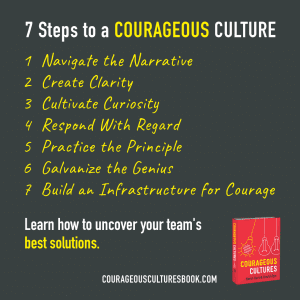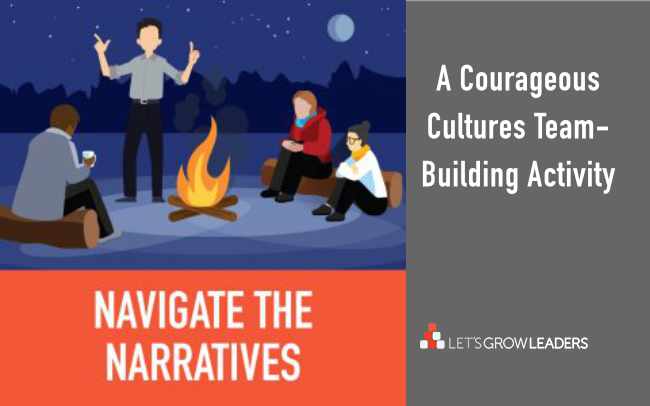Remembering micro-moments of courage makes it easier to do the right thing next time.
If you want your team to feel more courageous, remind them of times they’ve been courageous before. This team-building activity gives your team a chance to reflect on their micro-moments of courage. And, to share these moments with one another as they build trust and connection.
This conversation is incredibly powerful for two reasons. First, we know from Dr. Amy Edmondson’s research on psychological safety, that how we think about the past matters. People are more likely to hold onto a negative experience with speaking up or taking a risk, than a positive one. This activity reminds your team of the times they WERE BRAVE and how it made them feel. And second, by sharing strategic stories, your team will build trust and connection.
A Powerful (and Easy Team Building Activity to Encourage Courage)
 If you’ve read our book, Courageous Cultures, you know it comes with a downloadable Executive Strategy Guide.
If you’ve read our book, Courageous Cultures, you know it comes with a downloadable Executive Strategy Guide.
You can download the FREE Executive Strategy Guide, which includes all the Courageous Cultures “First Tracks” activities here.
A Step By Step Guide To Facilitate The Courage Mapping Activity and Discussion
This team-building activity is an adaptation of the Courage Map activity associated with the first step of building a Courageous Culture: Navigating the Narrative.
Objectives for the Courage Mapping Team-Building Activity
- Encourage individual reflection on personal acts of courage.
- Foster open communication and mutual respect within the team.
- Identify and reinforce shared values and lessons that contribute to a Courageous Culture.
Materials Needed
- Whiteboard or large paper for collective notes.
- Markers or pens.
- Printed worksheets for Courage Mapping (found in the Executive Strategy Guide).
Part 1: Individual Courage Mapping
This team-building activity starts with self-reflection.
Duration: 30 minutes
Instruction: Ask each team member to create a timeline of their career. Have them highlight at least three moments where they acted courageously. Then, invite them to reflect on the following questions: 
- What motivated me to be courageous in this circumstance?
- What did I expect to happen?
- And, what happened as a result?
- How do I feel about this incident?
- What values did it reveal as important to me?
- As a leader today, where would it be helpful to show up more like this or with these values?
Part 2: Group Reflection and Sharing
The real magic of the team-building activity is in the sharing. Give your team a chance to share their moments of courage. Cull out common experiences. Look for themes.
Duration: About an hour (depending on the size of your team)
- Setting the Stage: Create a safe and respectful environment for sharing personal stories.
- Sharing: Each member shares one significant act of courage from their timeline.
- Discussion: Facilitate a group discussion on each story, focusing on motivations, outcomes, and values (e.g. what… do you notice about yourself? Makes you proud? Did you learn?)
Part 3: Identifying Collective Themes
You can collect themes as you go along. Another best practice, summarize the themes of this team-building activity at the end.
Duration: 30 minutes
- Collaborative Analysis: Guide the team in identifying common themes and values emerging from the shared stories.
- Whiteboard Summary: Use the whiteboard to note down these themes and values.
Facilitator Tips
- Encourage honesty and openness but also respect boundaries.
- Ensure every team member has an equal opportunity to share and contribute.
- Be attentive and responsive to the emotional dynamics in the room.
- Use active listening and summarizing skills to clarify and validate shared experiences.
- Be prepared to handle sensitive topics with care and confidentiality.
More Courageous Cultures Team-Building Activities and Tools
In the following article we share links to more Courageous Cultures activities and tools and a link to watch our “How to Read Courageous Cultures With Your Team” recorded online event:
Leadership Book Club: How to Read Courageous Cultures With Your Team







0 Comments